Contents
1. Forward
2. Introduction
2. External influences and local issues
4. Strategy, vision and themes
5. Challenges
5.1 Constraints on Torbay's affordable house building
6.1 Build affordable homes for rent
6.2 Build and acquire innovative and specialist homes
6.4 Make a better use of our housing stock
7.1 Tackle conditions in the private rented sector
7.2 Improve energy efficiency and reduce fuel poverty
7.3 Keep people independent at home
8.1 Prevent homelessness
8.2 Offer intervention
8.3 Help households sustain accommodation
9. Action plans and governance
1. Forward
A home is special to everyone and directly contributes to good health, wellbeing, and life achievement. Having a place to call home is one of life’s main goals from where we can begin to build our lives. It offers warmth and shelter; and is the place where we feel safe, and secure, a place to shape family.
Since early 2020, most people have been spending a lot more time at home, not only as a place to live, but also as the workplace, the school, or the gym. This has highlighted stark inequalities in housing, with some residents enduring the lockdown in large homes with gardens, whilst others struggled in overcrowded conditions with no outdoor space. For some it has become the new place for employment, forever changing the way we think about the commute to work.
Housing can contribute positively to people’s mental and physical health, but all too frequently it does not. As a Council we will strive to address this by continuing to expand our innovative approach to deliver solutions and infrastructure to meet the wide variety of housing need in our communities.
The strategy sets out what the Council, with its partners, will be doing over the next 7 years to improve the housing situation for our current and future residents. It sets out the approach we will take with all our partners to work toward our vision.
2. Introduction
In 2021 Torbay Council declared a housing crisis to address local housing issues and announced via the Community Plan the challenge for economic and housing growth. Additionally, the ‘Thriving People’ vision announced an intent to work with key partners to ‘improve the delivery, affordability and quality of housing’. The Housing Strategy is part of that vision.
A balanced housing market is essential to sustainable communities, but this will not be achieved without the right level of new housing development, across all tenures. As well as providing desperately needed new homes, house building also delivers substantial benefits and better facilities for the wider community. It often goes unnoticed that increased capacity of schools, GP surgeries, new roads, community centres or sports facilities have been paid for as a direct result of development. New homes and improved facilities are key ingredients in developing economic growth and building communities; places where people want to live. The affordability and environmental sustainability of homes will also be crucial factors in getting the balance right between homes, jobs, the green environment and protecting the climate.
Beneath the Community and Corporate Strategy and the Local Plan sits the Housing Strategy that supports cross-organisational, collaborative working and lies at the centre of a number of stand-alone strategies, plans and policies that shape Torbay’s ambitions. The purpose of this Strategy is to assess our current position, look toward what we aim to achieve, making ‘evidence based’ decisions, and put in place performance-based actions that will be of benefit to our residents and communities.
Key strategic documents
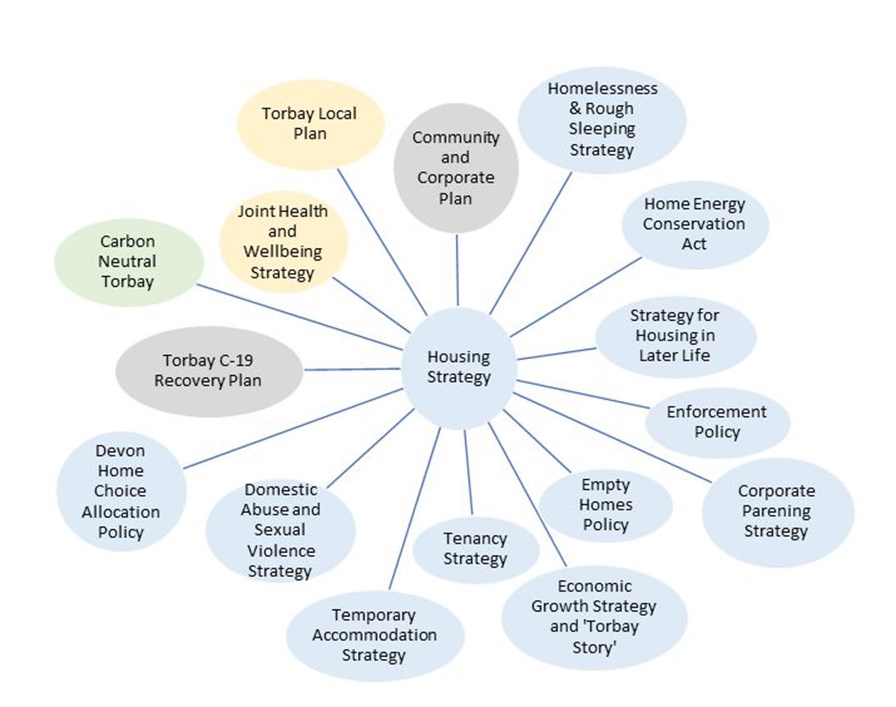
3. External influences and local issues
We know that there has been a huge increase in demand for available properties, both rented and for home ownership from people inside and outside the Bay. This has pushed up local prices and rents, making it more difficult for local households to afford.
Against an already compromised economic backdrop, ongoing financial uncertainty makes the operating environment for housebuilders and registered providers more difficult. For many, there are major concerns around the economic certainty to secure finance, the loss of funding streams and the shortage in both skilled and unskilled labour. Rates of inflation are increasing rapidly, and construction companies are feeling the effects as essential materials and skilled labour become significantly more expensive.
There has been, and will continue to be, an increase to the numbers of people needing help with their housing costs, particularly in the private rented sector. However, this welfare support is limited to the levels of our area’s Local Housing Allowance (LHA) that sets out the maximum level of Housing Benefit, or the housing costs element in a Universal Credit award, depending on the number of bedrooms the household requires.
Prior to the pandemic, there will be people living in homes that they could comfortably afford, however many households have now suffered major changes to their financial situation. Additionally, since the energy price cap was lifted at the beginning of 2022, millions have seen their heating and electricity costs rise, which has come alongside increases in the cost of food, taxes and other everyday expenses.
The Local Plan provides a framework for guiding development and investment across Torbay over the coming years. Our Masterplans (Policy SS2) for the regeneration of our town centres have been developed alongside our Economic Strategy, which represent the strategic objectives of what our town centres should aim to be. These areas should provide a mix of jobs and housing as part of the longer term growth trajectory to help bring new life and investment to those vital centres.
4. Strategy vision and themes
The strategy sets out what the Council intends to do over the next 7 years to improve the housing situation for local residents. It sets out 3 priorities and 3 cross-cutting principles, which cut across all the work we do. Within each theme we have identified key actions, which we believe will directly contribute to the overall sense of community health and wellbeing in Torbay.
Our housing priorities are:
- Improve housing supply
- Improve housing quality
- Improve housing support
Our cross-cutting principles:
- Put our customers first
- Tackle climate change
- Work in partnership
Cross cutting principles
As a service we are looking to deliver support and advice from a client, or customer, point of view. At Torbay, we want customers to easily give feedback, so we can put things right and do things better in future.
To meet Torbay’s 2030 carbon neutral target, we will need to reduce emissions by 178,000 tons of CO2 from our homes. Any residual emissions will need to be offset. A large amount of activity is ongoing, but to become carbon neutral by 2030 will require a considerable amount of work and effort. Torbay’s largest source of carbon dioxide emissions comes from domestic homes. In 2019 they made up 42% of Torbay’s total carbon emissions. Our Local Plan contains a range of policies (SS14 and ES1) to tackle climate change on new build homes, however, it should be noted that new dwellings are 44% more energy efficient than existing dwellings so, a key focus of this strategy will be to improve the energy efficiency of our existing homes, particularly in the private rented sector.
Whilst it is not solely the Council’s responsibility to provide resources for the decarbonisation of all homes in Torbay, ways to finance the scale of the transition will need to be found. The move towards decarbonisation also presents an opportunity if we can develop the skills locally that will be needed to aid this transition, and this has been reflected in the new Economic Growth Strategy.
The key principles of partnership working are, openness, trust and honesty, agreed shared goals and regular communication between partners. Partnership working is at the heart of our agenda for improving outcomes and making local, community services more cost effective.
5. Challenges
Many people in our local communities are struggling to afford private rented accommodation or buy a home. There is a shortage of affordable housing in Torbay and there is a risk that the housing crisis will not just impact upon the current generation, but also generations to come.
In Torbay the proportion of social rented stock (8%) is significantly lower than the national average (18%). Conversely, there is a higher proportion of private rented sector housing (26%) compared to 19% in England. The shortage of affordable housing means that low-income households are increasingly more reliant on the private rented sector, with nearly 70% of these households dependent on some form or housing subsidy.
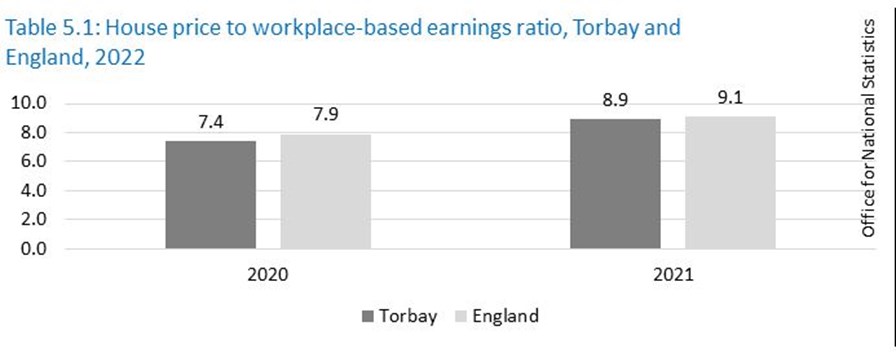
Housing is unaffordable in Torbay, primarily due to low wages in the area, rather than abnormally high house prices. However, house prices increased significantly post 2020, which has further eroded affordability. In 2021 median incomes in Torbay were £25,854 and median house prices £230, 000 making median houses 8.9 times average earnings. This ratio is almost the same as for England and Wales, where workplace earnings (£31,344) and house prices were both higher (£279,783). It is important to note that Torbay has an existing housing need, which has been made worse by the pandemic and subsequent shortage of accommodation due to higher demand for holiday accommodation.
5.1 Constraints on Torbay’s affordable house building
Open market housing is the main route to securing the delivery of affordable housing via S106 planning obligations. However, affordable housing can also be provided using Government grants and the Council’s assets, including land.
Provision of affordable housing through planning gain is currently sought on the basis of one third social rent, one third affordable rent and one third shared ownership, however the introduction of the Government’s ‘first homes’ (25%) for affordable ownership could potentially reduce the delivery of affordable rented dwellings.
The Government’s ‘standard method’ calculation for the delivery of homes places a requirement on Torbay to build 600 dwellings a year, plus a 20% (120) imposed ‘buffer’, due to the under-delivery of housing over the previous years. However, this is unlikely to be met due to the area’s environmental constraints and shortage of development sites. The number of affordable homes delivered relies upon planning obligations placed upon developers building homes on the open market, with the Local Plan (Policy H2) requiring affordable housing on a sliding scale of up to 30% on qualifying sites. The delivery of affordable homes will therefore be reduced due to local land constraints.
The Housing and Economic Needs Assessment (2022) identifies a local need for 721 affordable homes per year: 387 for rent and 334 for low-cost sale. However, since 2016, we have delivered an average of 339 market homes each year, 59 (17%) of which have been affordable. Need on the Housing Register, however, has increased by 50%, since 2018, with 1,572 applicants now in housing need.
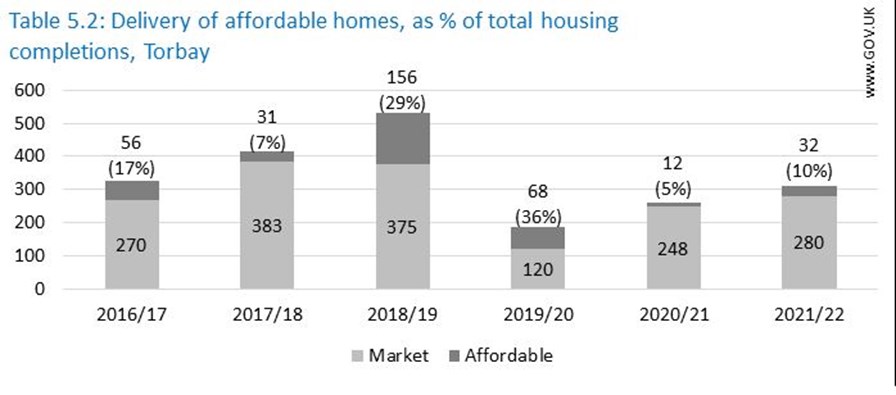
It should also be noted that a significant proportion of Torbay’s housing development comes from smaller sites, below affordable housing thresholds. Thus, whilst the supply of market homes is increasing, the delivery of affordable homes has been in decline.
Government policy states that ‘affordable housing should not be sought for residential developments that are not major developments’ (NPPF p64). Unfortunately, there is not sufficient brownfield land across the Bay to provide all the homes Torbay needs. Issues, such as site clearance and contamination further erode build viability on these sites. The current economic climate is making the situation worse.
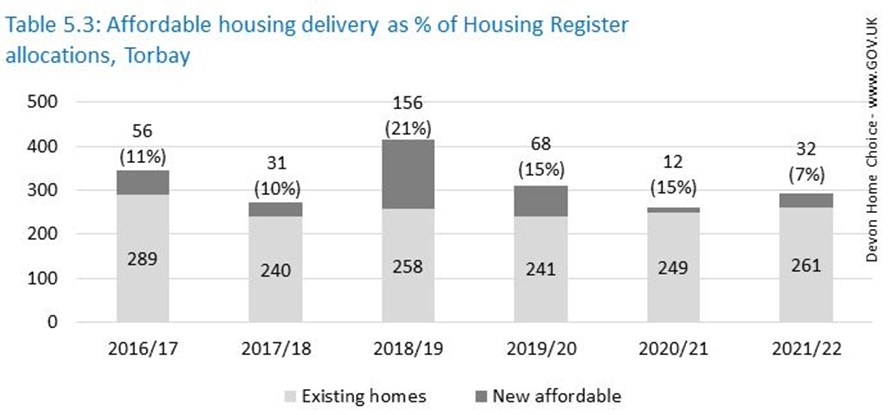
Since 2016, an average of 59 (23%) lets on the Housing Register are into new build, affordable homes each year.
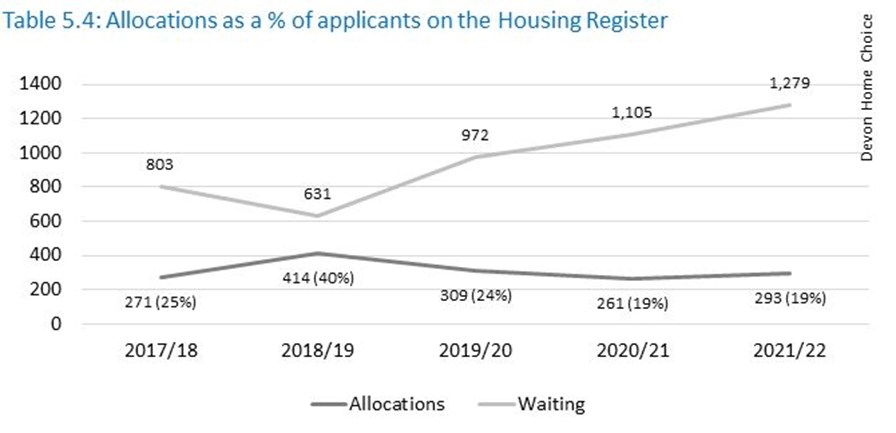
The Local Plan housing growth scenario will affect poverty, inequalities, and the delivery of affordable housing. Broadly speaking, a high growth scenario will provide the most affordable housing and economic prosperity; but will come at the cost of its environmental impact. Torbay has internationally important biodiversity associated with the South Hams Special Area of Conservation (SAC) at Berry Head, and the Marine Special Area of Conservation (SAC). The options will need to be assessed through a Habitats Regulations Appropriate Assessment (HRA), that will need to consider the in-combination effects of growth.
6. Improve housing supply
6.1 Build affordable homes for rent
Most of Torbay’s housing development comes from small sites, with no obligation to provide affordable housing, however officers have been working on opportunities to deliver affordable homes on land within the Council’s ownership, by reviewing existing assets and land ownership, including car parks, public open space, and other land appropriate for acquisition.
Homes built for rent by registered providers are the only type of homes that remain affordable for the majority of low-income households in Torbay. Traditionally, homes let on social rents are around 60% of the local market rent, but in 2010 the government introduced a new ‘affordable rent’ at rents on new homes of up to 80% of market rent levels.
Our strategy proposes a mix of Homes England grant and local housing investment, such as Council land and assets, with a view to establishing affordable rents. We will also strive to maximise energy efficiency, making our homes more affordable to rent, heat and run.
6.2 Build homes for low-cost ownership
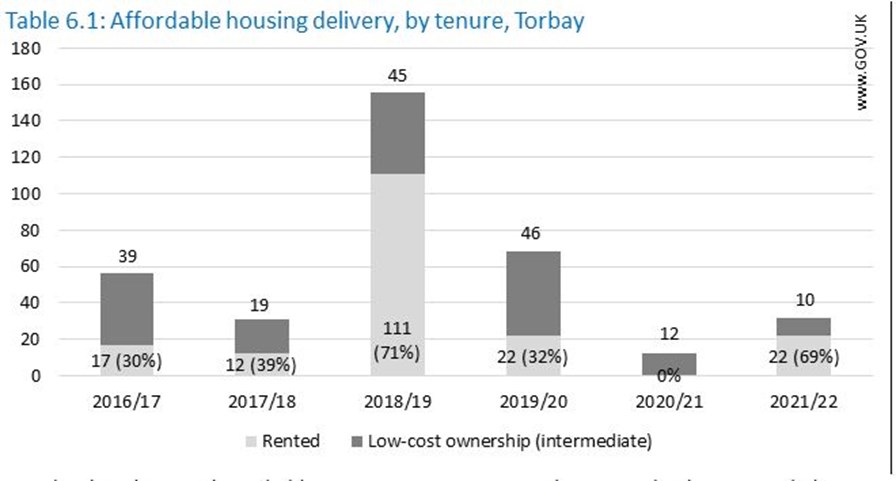
Many local working age households on average incomes struggle to raise the deposit needed to get a mortgage. One option open to them is low-cost home ownership, or ‘intermediate housing’, which is an umbrella term for homes for sale discounted below market rates, but more expensive than social and affordable rented products.
The Housing and Economic Needs Assessment (HENA) for Torbay shows that the highest net inflow of population is in the 55 to 59 age cohort, with high levels also in the 60 to 64 and 65 to 69 age groups.
These age groups are either retired, or nearing retirement, and accounts for almost all of Torbay’s population increase. Within a decade these households become more reliant on health services, placing a demand on Social Services and the NHS.
6.3 Build and acquire innovative and specialist homes
We wish to provide a range of specialist housing to meet the needs of existing local residents who may have to go into specialist accommodation. In Torbay, the population size has increased by 6.4%, from around 131,000 in 2011 to 139,300 in 2021.
The Torbay Housing Learning and Improvement Network (LIN) Assessment 2020, indicates a need to provide around 848 specialist housing units for older people by 2035, of which half should be for rent. Additionally, there is a need for 276 units of housing with care, again half for rent, and 370 nursing beds. Conversely there is an oversupply of about 188 ‘care home’ bedspaces.
6.3a Adult Social Care strategic housing need
Torbay Council and its NHS partners want to increase the use of home-based models of care and support and reduce dependence on residential care. This will allow people assessed as requiring social care and support to have a greater choice and control over how, where and with whom they live. Doing so means prioritising housing with varying levels of support for all age groups, enabling people to live well for longer in a home of their own.
Securing a long-term planned supply of appropriate housing to meet the diverse accommodation needs of Torbay’s Care Act eligible population is a complex task and requires a detailed understanding of supply and demand over a long time.
The Council, in partnership with the NHS and voluntary sector organisations, has prepared three key documents regarding housing needs in relation to adult social care:
- Identifying the Need for Specialist Housing in Torbay until 2030
- Strategy for Housing in Later Life 2020-2025
- Blueprint for Market Transformation in Torbay 2020-2030
These key documents set out the following requirements to make sure that the transformation of the adult social care market is supported by the availability of suitable housing across the range of care needs in Torbay.
People over the age of 65
27% of Torbay’s population are aged 65 or over, compared to just 18% of population across England. By 2040, this is expected to rise to one in three (34%). Torbay has 550 nursing home beds, some of which are in residential care homes, but this is insufficient.
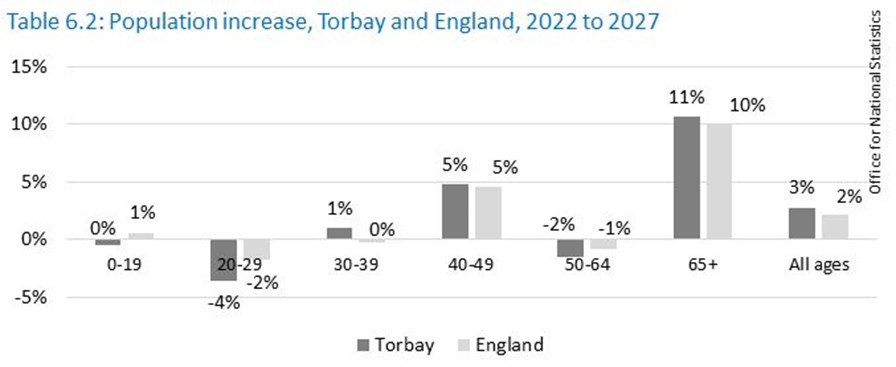
Over the next 5 years we will deliver 170 (34 per year) additional 1 bed and 2 bed units of sheltered, rented, social housing in Paignton and Torquay, providing housing for older people with Care Act eligible needs. Commissioners have also identified a need for an additional 340 units of this model of housing for leasehold purchase.
Over the next 10 years the Council needs to work in partnership with housing providers to deliver more sheltered housing for rent and purchase. All models of housing with support help older people to remain independent for longer, improving life outcomes, thus reducing the need for expensive health and social care alternatives. Commissioners have identified a demand for 1,462 additional sheltered housing units for rent and 1,938 units for private purchase by 2035.
Local planning policy needs to make sure that enough affordable housing and services are made available to help the older population to ‘age in place’. This needs to be done in parallel with the development of health and social care services. Homes should be of good design with the ability to be modified as people’s abilities change. The Council should make sure that the older population are well-informed about the services that are available.
People with learning disabilities and autism
To meet the housing needs of people with a moderate to severe learning disability, 12 additional units of social rented housing with support are required annually. To meet the housing needs of people with very complex learning disabilities and autism, 2 to 3 units of highly adapted, purpose-built accommodation are also required each year (Projecting Adult Needs and Service Information assessment).
People should be able to choose where, how and with whom they live. We need to move away from residential care and significantly increase our supported living and ‘extra-care’ provision for people with learning disabilities. These models of care enable independence, and social participation, helping people to be part of their community, thus reducing the cost and level of state-funded services and reducing the risk of out of area admission.
All organisations involved in the delivery of housing should be able to provide housing applications and tenancy documentation in a format that is accessible for people with a learning disability, cognitive impairment or neurological diversity.
Housing providers and commissioners, including Homes England and the NHS need to work together to assemble capital funding packages to ease the high cost of developing bespoke housing options for people with complex needs that would otherwise see them ‘placed’ outside of Torbay and away from family and their circles of support.
People with enduring mental illness
To meet the housing needs of people living with mental illness in Torbay, 30 additional units of housing with support, in single, or in planned clusters are required over the next 5 years (6 per year). More people under 65 with mental health issues should be supported to live as independently as possible in their chosen communities within the Bay.
Too many younger adults with mental health needs are living in residential care. For adults in contact with mental health services, less than half (45%) are living independently, this is lower than the England average (58%). Supported living not only costs less than residential care, but increases self-determination, control, and citizenship, which are the basis of recovery.
The Council and its partners need to improve the support available for people with mental illness to navigate the social housing application process. We also need to develop effective tenancy sustainment services to help people living chaotic lives. There should be a clear step-down process from intensive supported into increasing levels of supported independence, offering greater opportunities for recovery.
6.3b Children’s Service’s housing need
Over the last year, there has been an increase in the number of families needing to access emergency accommodation. In May 2022, 157 households, of which 62 (39%) were families, were living in temporary accommodation. This negatively impacts family life, as families experience a prolonged detachment from their local communities, away from friends, family, schools and social networks.
In situations where a family is not found eligible for a homeless duty by the Council, the responsibility of housing families returns to Children’s Services. Torbay is the corporate parent to cared for children from 0-18, and under the extended duties is also the corporate parent to all care experienced young people from the ages of 16 to 25. As of April 2022, the care experienced team supports 118 former young people aged 19 to 21, and a total of 177 care experienced young people aged 16 to 25, a total of 295.
Recent trends show Torbay to be the corporate parent to nearly 5 times the England average. With a 42% increase since 2011, this trend is set to continue. On average, over the last 10 years, Torbay has 302 looked after children, compared to 62, the national average.
During both of the recent Ofsted inspections of Local Authority Children’s Services (LACS) in March 2021 and 2022, the following challenges faced by Torbay regarding housing and accommodation were noted:
- The sufficiency and availability of highly specialist placements provision
- The suitability of after care and the range of housing options for care-experienced young people
There was a clear direction from the regulators that accommodation for care experienced young people must be a corporate priority for Torbay. There is an urgent need to create housing stock that provides independent living and move-on accommodation options for our care experienced young people. A scoping exercise has been undertaken, considering the number of properties that will be required for the next three years. It estimates that 101 homes need to be delivered in 2023/24, with a further 127 in the following year.
If the housing stock remains inaccessible for care experienced young people, there is a significant financial risk associated with other options, as well as contravening Government guidance.
More than a third of care experienced young people told us that we needed to help prepare them for living alone, including how to manage money and their emotions. (Torbay Bright Spots ‘Your Life After Care’ survey, 2021). Since receiving feedback we have entered into contract with ‘Listening Works’ to provide financial and emotional support for all care experienced young people. Additionally, a ‘Transitions Panel’ is now in place that tracks independence plans for those over the age of 14; promoting independence and emotional regulation management skills.
6.3c Single households
The Housing Register regularly records that half of applicants are single households on low incomes, reflecting a sustained local demand for single affordable housing units. Often people find shared accommodation more affordable than renting alone and, in an area, when the average house price is nine times the average salary, local people, particularly the young, need all the help they can get.
Most rental homes already on offer are owned by small-scale landlords, who provide tenants with an inconsistent quality of property and management experience, and who may well ‘cash-out’ of the market at any time, thus rendering the tenant homeless.
It is clear that more tenants are looking for effective property management and security, and there is potentially a gap in the market for developments in the right locations. Build to Rent is a term used to describe private rented property that is designed for a rent model that allows property investors to achieve long-term investment returns, while providing renters with more options and better quality accommodation. These developments are typically owned by companies, such as property companies, or pension or insurance investment companies, and are let directly, or through an agent.
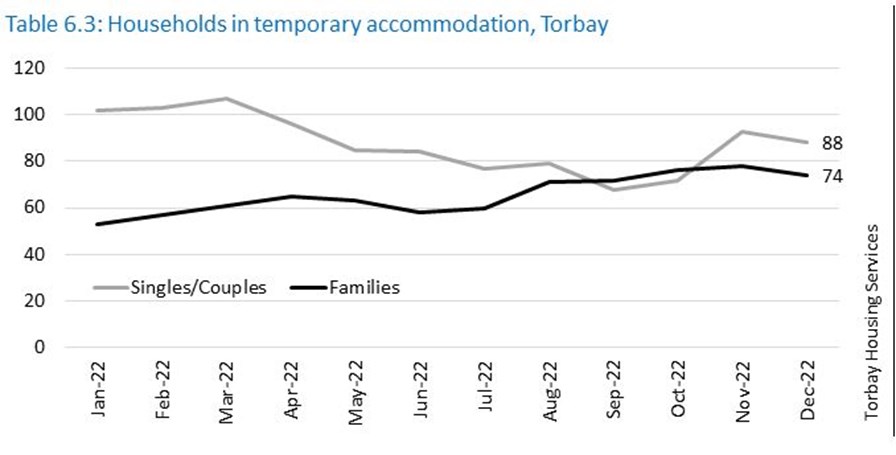
6.3e Domestic abuse safe houses
The Domestic Abuse Act (2021) places a statutory duty on unitary authorities, like Torbay to provide support to victims of domestic abuse and their children within safe, appropriate accommodation. Under the legislation, temporary accommodation, such as homelessness hostels, hotels and bed and breakfast accommodation are not considered appropriate. The Torbay Domestic Abuse Safe Accommodation Needs Assessment, undertaken in 2021, highlighted that finding enough accommodation for victims was a challenge, particularly if one considers that half the number of victims who presented to the local authority as homeless, were families with children.
Aside from the capacity for accommodating different families and households we heard through the consultation with victims that they often found shared refuge spaces difficult. Some discussed tensions between residents, as well as being re-traumatised by hearing others’ injuries, both mental and physical. Whilst some victims and survivors did benefit from shared accommodation, it is clear from the findings that the dispersed, self-contained approach is generally seen as more favourable.
Overall, in terms of capacity, Torbay is operating in line with the Council of Europe thresholds for the number of refuges, however given the current landscape, additional capacity needs to be explored. In this regard Torbay has worked with partners to acquire an additional 7 units of accommodation. In total we now have 21 units of dispersed, self-contained units of accommodation. The biggest gap currently in terms of safe spaces are for those with a disability with only 1 safe space having mobility access. It is estimated that a further 3 units will be required.
6.3f Gypsy and traveller accommodation
In comparison with other parts of Devon, and the Southwest, Torbay has played a limited part in the lives, traditions and movements of the travelling community, whether Romany, Irish or New Age in origin. There are no long-established cultural connections with Torbay, or any historical employment links for travellers in the area. There are no records of any planning applications having been submitted, by private individuals, or public bodies, for sites for permanent residential pitches, or transit pitches.
The 2015 Gypsy and Traveller Accommodation Assessments (GTAA) identified a need for 2 transit pitches. The Local Plan review seeks to identify these sites.
6.4 Make better use of our housing stock
Clearly Torbay will be unable to build the number of new affordable homes required to meet the current need. We are conscious that we need to work more innovatively to address the increasing need for housing. By working with partners across the Bay, we intend to make better use of the housing stock to achieve this aim.
6.4a Bring empty homes back into use
Bringing empty homes back into use is a sustainable way of creating much needed homes and reduces the negative, anti-social impacts of empty properties upon communities. Homes may become empty for several reasons; in most cases they are empty for a temporary, short-term situation, for example awaiting sale, letting, or being renovated prior to occupation. Homes empty for under 6 months will often come back into use without any Council intervention, yet some may take longer, depending on the financial and personal circumstances of the owner.
As of October 2021, 892 dwellings in Torbay were empty for longer than 6 months. This represents 1.4% of Torbay’s total housing stock. A long-term empty home is defined as 'an unoccupied property for a period of six months or more'. Longer term, empty homes are of interest to the Council because they are a wasted resource and can sometimes be in a dangerous state, detrimental to the area. 284 dwellings were empty for longer than 2 years.
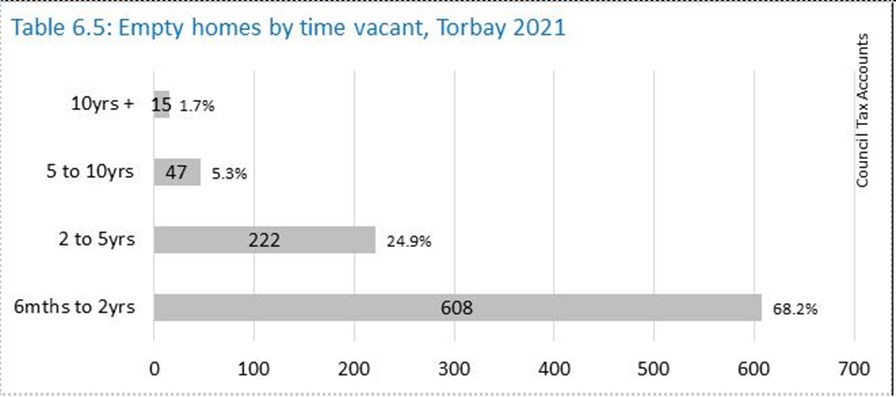
In 2021 the Council adopted an Empty Homes Policy, the aim of which is to target and bring back into use the 284 dwellings empty for longer than 2 years. This ensures the effective use of the housing stock in Torbay, whilst reducing the negative impacts on the local community.
6.4b Review our social housing stock
One of the key priorities of the Housing Strategy is to make the best use of existing homes. As part of that commitment, we are working with local registered providers to review our social housing stock to prioritise action on under occupation. We will work together to help those wishing to downsize, thus freeing up larger, under-occupied homes, in a bid to reduce waiting times and prevent homelessness.
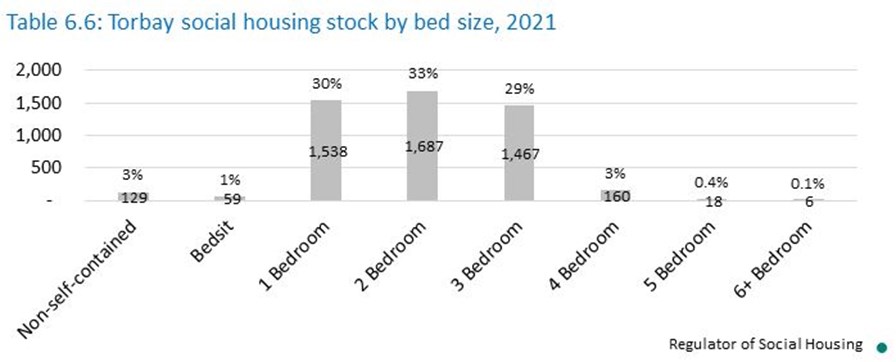
The proportion of social rented stock in Torbay (8%) is significantly lower than the national average (18%). There are currently 1,572 applicants on Devon Home Choice, with 26% households reporting that they lack 1 bedroom. Average waiting times before being housed can be between 59 and 80 weeks depending on band and preference. This can leave families in expensive private rented accommodation, often in overcrowded housing scenarios. Furthermore, since 2018 there has been a 50% increase in the number of applicants on the Housing Register, with the trend set to continue.
There is a distinct lack or larger family homes, both in the private rented and social sector in Torbay, so we need to focus on freeing up these much needed homes. Over the last 3 years, an average of 287 homes were allocated each year to households via the Housing Register. This means that, on average, around 6 homes are made available each week.
The number of homes owned by the 4 largest registered providers represents 88% of the total social housing stock in Torbay. The Council is therefore concentrating its efforts by working with the main providers, but we are open to collaborating with other 24, once our policies are in place. We potentially have 309 homes being under occupied, however, there are 1,682 (37%) social homes with three bedrooms or more that could be explored.
| Registered provider | Total | 6+ bed | 5 bed | 4 bed | 3 bed | Under occupying by 2 bed |
|---|---|---|---|---|---|---|
| Sanctuary | 2,653 | 4 | 13 | 52 | 955 | 174 |
| Westward | 1,247 | 2 | 5 | 35 | 329 | 75 |
| LiveWest | 559 | 0 | 0 | 22 | 107 | 27 |
| Sovereign | 541 | 0 | 0 | 44 | 114 | 33 |
| Total | 5,000 | 6 | 18 | 153 | 1,505 | 309 |
7. Improve housing quality
Housing has a key role to play in health and wellbeing. The poor condition of a property can negatively affect the physical and mental health of our residents. Similarly, some people’s physical health needs, particularly for older residents, can restrict their ability to live an independent life without some adaptations to the home.
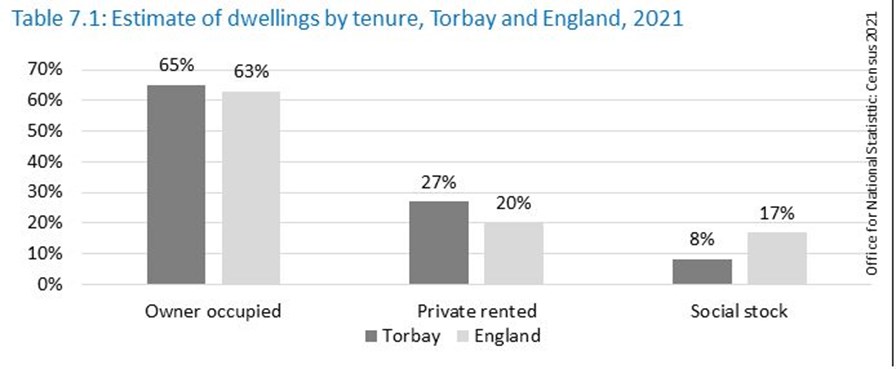
In Torbay, over a third of households (35%) rent a home, with 27% renting from a private landlord, far greater than the national average of 20%. The remaining 65% owner occupy. Results from the Census 2021, suggest that Torbay has 63,000 dwellings.
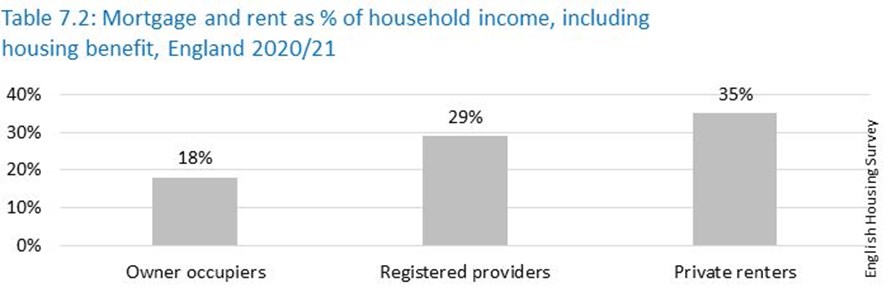
In general, the condition of the social housing stock in Torbay is better than other tenures for indicators relating to hazards, disrepair and energy efficiency. This is due to government requirements placed upon registered providers; however, we are open to complaints from the social sector and will work with registered providers to drive up standards.
Generally, owner occupiers spend less on housing costs and can, on the whole, take action against disrepair themselves, whilst implementing their own energy efficiency measures. However, a number of owner occupiers, usually retired households on reduced incomes, can be said to be ‘equity rich and cash poor’.
The expansion of the private rented sector has focused attention on the need to improve conditions in this tenure. The English Housing Survey (EHS) estimates that in 2019, 23% of PRS homes did not meet the Decent Home Standard – around 1.1 million homes. This compares with 18% of owner-occupied homes and 12% of social-rented homes. PRS homes were more likely to have at least one Category 1 hazard under the Housing Health and Safety Rating System (HHSRS).
The housing health and safety rating system (HHSRS) is a risk-based evaluation tool to help local authorities identify and protect against potential risks and hazards to health and safety from any deficiencies identified in dwellings.
7.1 Tackle conditions in the private rented sector
The private rented sector (PRS) offers a flexible form of tenure and contributes to labour market mobility. Once the domain of younger people it is now home to a wider range of age groups, in particular those aged 35 to 44. On average, households in the PRS move house every 4 years; four times more often than those who own their homes.
The housing conditions in the private rented sector are worse than for any other, so making sure that the quality and standard of the private rented sector is a priority for us. We also focus much of our work in this sector because tenants have little, or no control over getting remedial works carried out, so we use all the tools available to take action against poor standards.
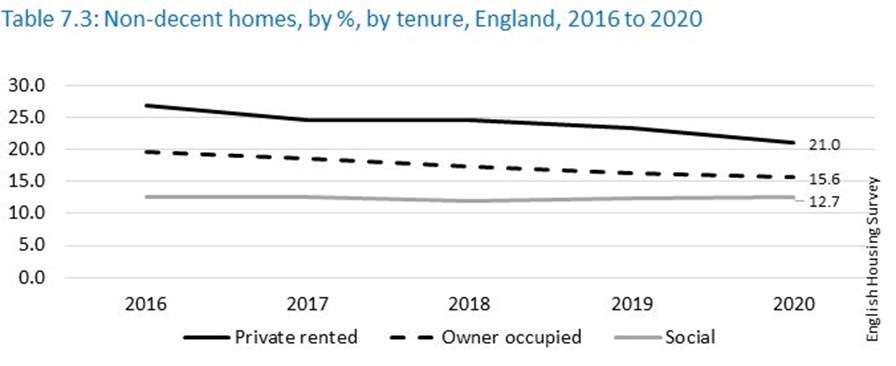
In Torbay there is a large percentage of low-income households renting privately, driving up fuel poverty. A low-income household is defined as a household in receipt of one, or a number of benefits. In Torbay’s private rented stock, 68% of households claim Housing Benefit, or the housing element of Universal Credit. Low income is a contributor to fuel poverty and as such, a large percentage of households who privately rent find themselves fuel poor.
Additionally, just under a third of households owed a homelessness duty in Torbay was due to the end of private rented tenancy (29% in 2021). Not only must we work with private landlords to drive up housing standards, but we need to work more holistically to protect and sustain tenancies.
The scale of the issues facing the private rented sector are such that the answer does not lie with regulation alone. We must create the right environment to encourage self-compliance by working alongside landlords, property agents and landlord associations, offering opportunities to all landlords and letting agents operating in the Bay.
7.1a Enforcement
Local housing authorities play a key role in protecting the health, wellbeing and the consumer rights of residents. Our Policy helps to promote efficient and effective approaches to regulatory inspection and enforcement that improve outcomes without imposing unnecessary burdens. It sets out what owners, landlords, their agents and tenants of properties can expect from us and what we expect of them.
We work with private landlords to drive up standards, but the Council will also take action against any landlords who do not comply with legislation, in line with our Housing Enforcement Policy.
In 2019/20, the year prior the COVID-19 visiting restrictions, the Housing Standards Team received 848 enquiries and complaints (16 per week) about housing related issues in the private rented sector. From these, the Housing Standards Team identified and enforced against 578 Category 1 and high scoring Category 2 HHSRS hazards. Using the BRE health cost calculator, the hazards remedied resulted in a cost saving to the NHS and wider society of approximately £740,000.
The main issues identified relate to poor heating, risk of fire, damp and mould and falls. Whilst the Team address all hazards during inspections these four issues remain a strategic priority.
On average, Torbay Council serves 49 legal notices each year. These notices ensure that works are undertaken to remedy disrepair, establishing that we will use our powers of enforcement to drive up housing standards. We have also served a number of civil penalty notices as an alternative to lengthy and costly prosecutions of up to a maximum of £30,000. Although Torbay is a small unitary authority, we undertake similar levels of enforcement activity as that of some of the larger metropolitan areas.
The Planning Department also have discretionary powers to take enforcement action where unauthorised development has taken place. Unauthorised development includes building works, changes in the use of buildings or land, the appearance of buildings or land, or works to listed buildings.
7.1b Houses in multiple occupation
The definition of a ‘House in Multiple Occupation’ (HMO) is complex and subject to various tests and interpretations. However, a simplified definition is: ‘any dwelling occupied by 3 or more people comprising of 2 or more households who share facilities, such as a kitchen, bathroom and/or toilet and occupy the property as their only, or main residence’.
In larger towns and cities, HMOs are commonly occupied by students, but there is a growing number of young professionals and migrant workers choosing this type of accommodation, as they are often more affordable, with bills included. HMOs are often occupied by the most vulnerable people in our society; in Torbay they are widely occupied by single households in receipt of benefits. These dwellings were often not built for multiple occupation, so the risk of overcrowding and fire can be greater in these dwellings than with any other type of accommodation.
In 2018 the national HMO licencing regulations were changed. As a result, the number of licenced HMOs in Torbay increased to 134. Licensing has been successful in driving up standards, making these larger dwellings safer places in which to live.
A robust assessment of various data sources, including Council Tax records, Housing Benefit claims, and bin collections were undertaken to identify unlicensed HMOs in the Bay. The public can also report suspected unlicensed HMOs via our website. Properties found to be operating without a licence are subject to action in accordance with our Housing Enforcement Policy and non-compliance may result in paying a higher licence fee, a civil penalty of up to £30,000, or even prosecution. As of July 2022, 9 civil penalties have been issued for unlicensed HMOs, with an additional 7 properties that were required to pay the higher application rate due to late licensing.
Identifying non-licensed HMOs remains a challenge to all local authorities in the absence of a much discussed, but not established national landlord registration scheme. It is estimated that approximately 1,450 buildings in Torbay are being used to house multiple households. Their identification remains a strategic priority for the Council.
7.1c Park homes
A park home is a permanently occupied, prefabricated building located with others in a dedicated area, or site. Downsizing to a park home is often viewed as the ideal move for cash-strapped pensioners. On the whole, park homes are cheaper than traditional bricks and mortar, but the costs don’t stop at the purchase of the property. Residents will also need to pay a ‘pitch fee’ or ground rent to the site owner, which increase in line with retail prices index (RPI) inflation each year.
Additionally, heating is primarily provided through high cost fuels, such as liquefied petroleum gas (LPG), this coupled with their poor thermal structure this makes them difficult to heat and often count as ‘fuel poor’. According to the latest Housing Condition Survey residential caravans had the highest rate of thermal comfort failure at 51%.
It should be noted that Torbay has a relatively low number of park homes compared to other Devon districts. In 2021/22 the Council recorded 239 park homes, over 6 sites.
7.2 Improve energy efficiency and reduce fuel poverty
The carbon emissions from our area will fall as our homes and businesses become more energy efficient. The widespread reliance on gas as an energy source will mean few households will be immune from rising bills. However, homes with poor fuel efficiency will be hit hardest by energy price rises. Nationally, households who live in a property they own, or rent from a registered provider have the least likelihood of being fuel poor at 8% and 19% respectively. However, households living in privately rented accommodation are most likely to be fuel poor (25%).
Nationally, 54% of homes in England have an EPC rating lower than band C, for Torbay it rises to 75%. For those with lower EPC ratings, energy bills can be considerably higher.
Fuel poverty is caused by a number of factors:
- Low income
- High energy prices, which are often made worse by higher tariffs for both low-volume users, those not able to pay via direct debit and those unable to access the cheapest 'online only' deals
- Poor energy efficiency – for example, inadequate insulation, inefficient heating systems and under-occupancy
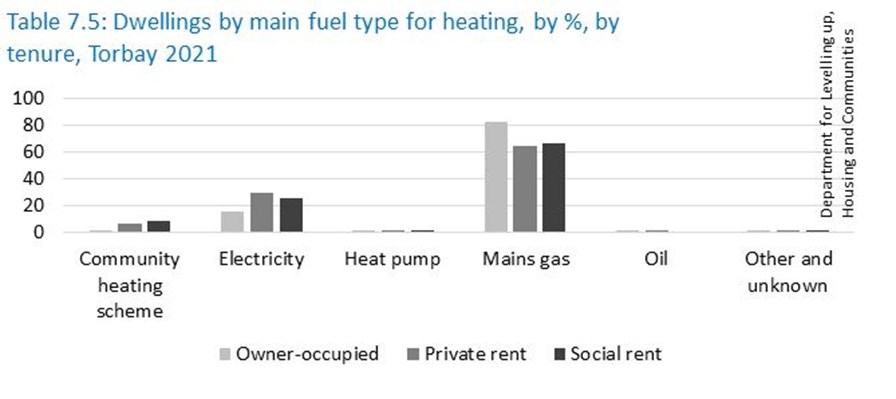
Fuel poverty is most common among vulnerable households:
- Those on low incomes.
- People with children under the age of 16.
- People with disabilities or suffering from a long-term illness.
- Older people
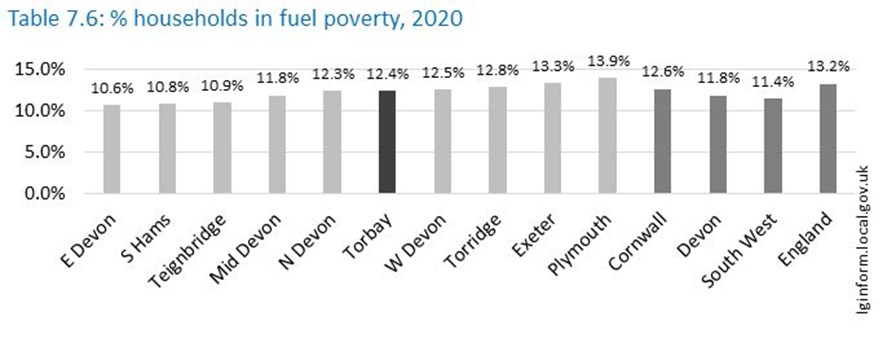
There are a number of factors that are associated with the energy efficiency of housing, including property type, tenure and when it was constructed.
Based on local data it is estimated that 4% of homes in Torbay have an EPC rating below band E compared to England at 2.7%. Nationally, this rises to 4.3% in the private rented sector, higher than for any other tenure. This figure has reduced year on year since 2020, when the Government stipulated that landlords could no longer let properties covered by the Minimum Energy Efficiency Standard Regulations (MEES) if they have an EPC rating below E, unless they have a valid exemption in place.
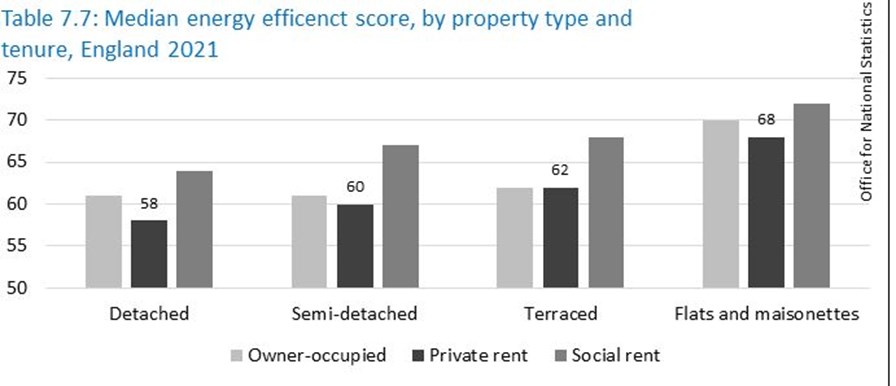
By 2030 the Government aims for as many privately rented homes as possible to be upgraded to EPC band C, where practical, cost-effective, and affordable. Nationally, more than half (54%) of all dwellings fall below band C, for Torbay this increases to 75%. In fact, we generally fall behind the national average for energy efficiency.
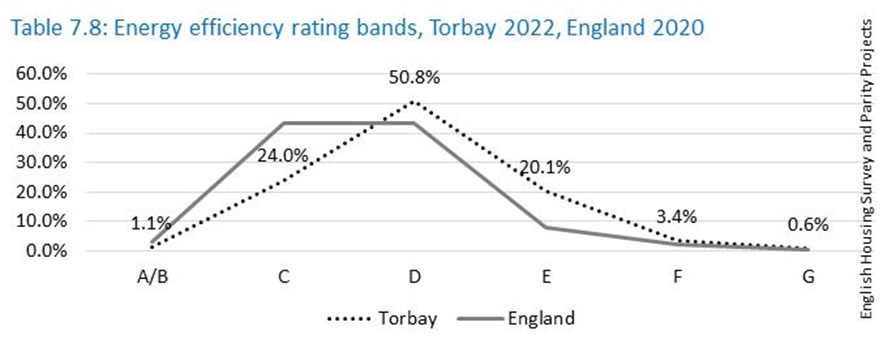
The Council has developed a ‘compliance and enforcement plan’ to contact all private rented properties in the Bay where the energy performance certificate (EPC) falls below band E, where it has expired, or where there is none. This requires the checking of approximately 19,000 records. By improving the energy efficiency of homes, we can increase our energy efficiency in the Bay, as well as help occupants save money on their fuel bills.
We have been working with partners in Torbay to utilise Government initiatives, such as ECOflex to target those most in need. Since 2019/20 an average of 214 homes a year have receive energy efficiency measures through the scheme.
7.3 Keep people independent at home
Getting housing right for people could have immense benefits for society and the economy. Although there are positive initiatives in the pipeline, they are not enough to respond to the rapidly expanding population of older people, in a way that significantly extends the options available.
Maintaining independence and the quality of life is one of the keys to ageing well and mitigates the increasing demand for more expensive care interventions and cost to the NHS. It is easier and less costly to adapt a house for people who develop a mobility problem, or disability, both young and old.
7.3a Disabled facilities grants (DFGs)
Households who need to adapt their home to allow them to live independently and safely, may be able to get help with a Disabled Facilities Grant (DFG). This grant is means-tested, which generally means that if you can afford to do the work yourself, you will not qualify for a grant.
Following an assessment by an occupational therapist, typical adaptations can include:
- external ramps, or internal stair lifts, or widening of doors, helping you move more easily into and around your home
- a level entry shower if you cannot use the bath safely
- providing lower level kitchen worktops for wheelchair users
Prior to the Pandemic, each year we were helping around 143 households to remain independent at home. On average £1,000,000 is spent each year in Torbay to undertake this work and assist people of all ages, including children.
The speed and efficiency with which adaptations are provided can make all the difference between people staying in the comfort and security of their own homes, or suddenly being forced into more expensive care options, such as residential care, or even hospital. Unfortunately, adaptations are often only considered in a crisis situation, so working to make people aware of their housing options in later life is a key consideration, not just for those who are eligible for the grants.
Regarding early assistance, the Council will work more closely with NHS partners to help households prepare their homes for the future. Where residents are admitted to more ‘acute’ care, such as hospital, it is important that we offer a rapid, co-ordinated response to undertaking works, to promote a safe, timely discharge.
8. Improve housing support
Homelessness has a serious and harmful effect on those who experience it. No household should ever have to experience homelessness. Our approach is to prevent homelessness at the earliest opportunity, before individuals, or families lose their home. We are developing a separate homelessness and rough sleeping strategy that will be published during the life of this strategy. It will contain a lot more detail about how we intend to tackle homelessness and its causes.
Due to the modest proportion of social housing and the low supply of new build affordable homes Torbay is reliant upon the private rented sector to discharge its homelessness duties. Due to the availability of converted flats, hotel and guest house accommodation in the Bay, Torbay not only draws low-income households, but also receives households from other authorities discharging their duties. In 2020/21, we saw 43 households from other local authorities placed in temporary accommodation, 7% of all placements. Over time, these households may fall into the Torbay system, thereby exacerbating the problem.
Recent private rental increases, often £150 to £200 above the local housing allowance, have pushed rented accommodation beyond the reach of low-income households and families, also making the Council’s task of finding affordable accommodation more challenging. Additionally, there has been some constraint in private rented stock, as some landlords ‘cash out’ and some convert to the short-term lettings sector, particularly Air BnB style lettings for the holiday market.
The growing number of low-income households in Torbay who are reliant on housing subsidy, such as Housing Benefit, or the housing element of Universal Credit in the private rented sector is significantly higher than national and regional averages and at the upper end of the scale for benchmark authorities. Interestingly, Torbay has approximately twice as many households renting privately in receipt of housing subsidy than the total number of social homes.
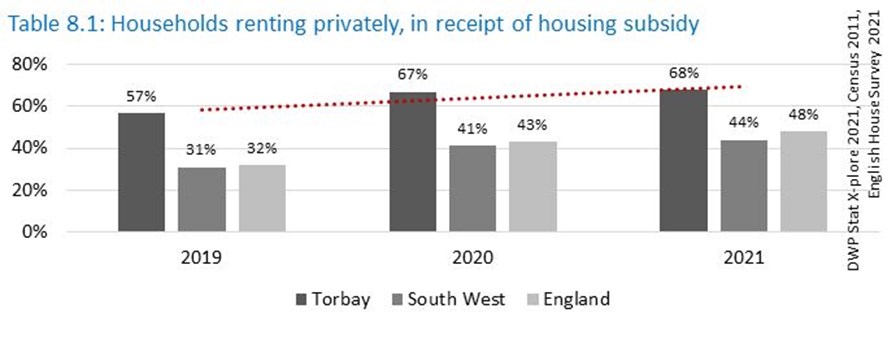
8.1 Prevent homelessness
Prevention means helping those at risk of losing their home with the necessary resources and support to stabilise their housing situation and to ultimately reduce the risk of the repeat homelessness by improving social and economic integration. Over the last two years, the Housing Options Team received around 13,000 calls each year. In2021/22 emergency calls about being ‘homeless tonight’ increased by 12%.
Whilst all calls are important to us, as potentially any call could lead to homelessness and early intervention, focussing on emergencies must be a priority for us to fulfil our homelessness duty.
Although there are many reasons for homelessness, last year, the most common reasons recorded locally were: the loss of a private rented home (34%), family and friends no longer willing, or able to accommodate (19%) and domestic abuse (12%). For many people there will be several reasons; for some there will be multiple, complex reasons. Our primary focus is upon helping households to remain in their own home, provided that it is safe and suitable for them to do so. There are a number of in-house services available to help households remain in their homes, including:
- financial and debt advice
- work with landlords and lettings agents
- mediation with family and friends, or landlords
- partnership work to tackle harassment and domestic abuse
- partnership work to deal with anti-social behaviour
- taking a trauma informed approach to supporting those with complex needs
In 2020/21, of the 3,454 calls made to Housing Options Team as ‘homeless tonight’, 30% were assessed as being owed a homelessness duty. A Housing Prevention Officer has been recruited to identify gaps in our prevention offer by reviewing and understanding trends based on data. By promoting a more holistic approach to tackle homelessness we hope to reduce the number of presentations.
8.2 Offer intervention
It is not always appropriate for people to remain in their existing home and sometimes it is not possible to prevent homelessness. ‘Intervention’ covers a broad range of activities that ensure local people who are made homelessness are given the support and help they need to access and sustain suitable accommodation.
To intervene effectively to relieve homelessness, we will:
- Act to minimise the use of unsuitable emergency accommodation
- Seek to improve access to a range of accommodation options, both temporary and permanent
- Improve access to, and the effectiveness of support services
- Continue to build on our commitment to end rough sleeping within the Bay using targeted outreach and the development of homelessness and health pathways
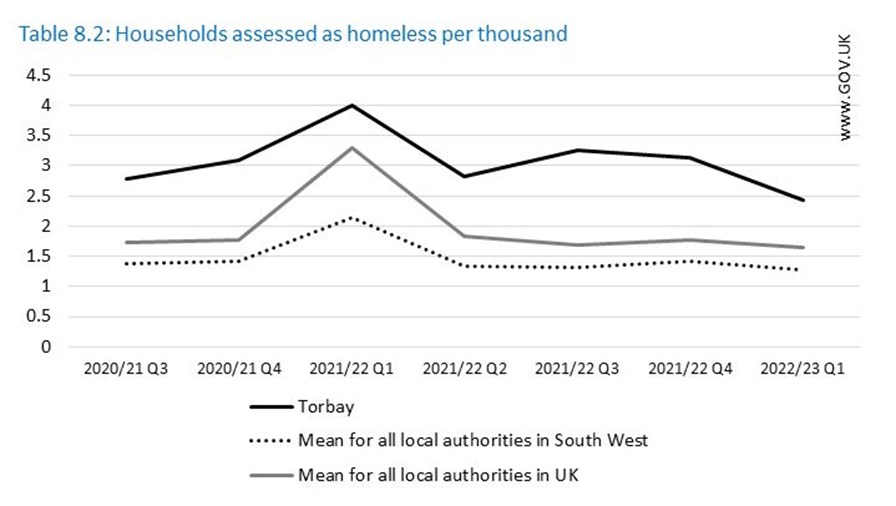
Homelessness data across 2019/20 and 2020/21 shows the total number of households assessed as homeless. Over recent years Torbay saw a high proportion of households per thousand population assessed as homeless. This is more than both the national and regional figures.
Due to the large private rented sector and modest social housing sector, Torbay is heavily reliant upon the former to discharge its homelessness duties. For example, in 2021/22 we discharged our homelessness duties into the private rented sector in Torbay (59%) at above the national (34%) and regional (36%) rates. As discussed throughout the strategy, tenancies in the private rented sector are generally more volatile and likely to yield higher homelessness applications and acceptances (38%) than from any other tenure, thus creating a repeating cycle of homelessness.
Given increased demand and the recent price increases in the private rental market, pushing accommodation beyond the reach of low-income households, finding more permanent affordable accommodation has become more challenging. The Council is willing to work with local landlords who are willing to rent accommodation at affordable rents, in return for help and assistance to manage the properties. By providing support, guidance, and mediation, we hope to maintain tenancies and reduce the high churn within this sector.
8.2a Addressing rough sleeping
We continue to build on our commitment to end rough sleeping in the Bay by using targeted outreach and the development of homelessness and health pathways. Rough sleeping is the most extreme form of homelessness, and it is therefore right we take action to help people off the streets. The theme throughout this strategy is to make sure that the entire system is working to prevent all forms of homelessness, but also to work across the Council, and with partners to deliver more affordable homes, and work with the private rented sector to promote longer, more secure tenancies.
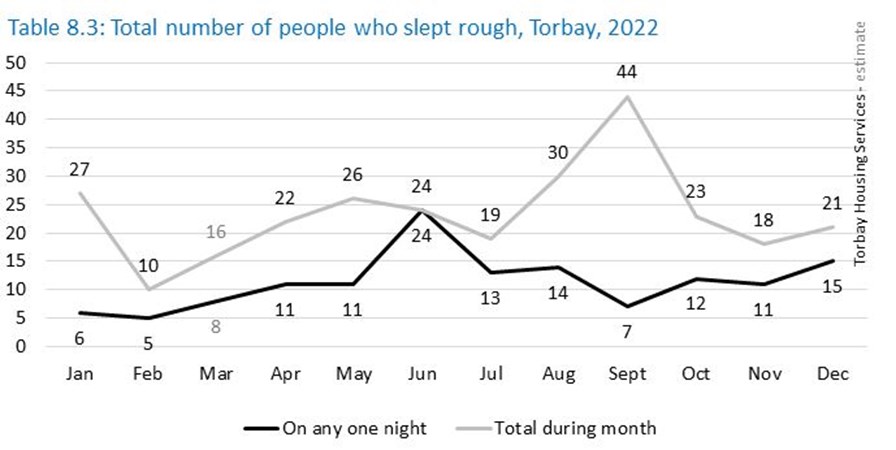
Prevention is vital, but if we are to ensure no one has to sleep rough again, we must act and intervene to support the people who are experiencing it. We need to ensure that people have support in place to move into sustainable accommodation. A stable home is an essential element in a person’s recovery from rough sleeping and needs to go hand in hand with flexible support that is tailored to an individual’s needs. For this reason, we are developing a new routes into temporary and more permanent accommodation.
8.3 Help households sustain accommodation
We need to make sure that our interventions are focused towards helping people to sustain safe and suitable accommodation in the long term. Sustainment also means breaking the cycle of repeat and chronic homelessness and enabling people to lead healthy and productive lives.
There are now two resettlement officers within the Housing Options Team. Their role is to visit all households in temporary accommodation to ensure they are providing up to date information to assist timely homeless decisions. Visits also identify any support needs that are required and that clients are ‘tenancy ready’ by maximising their income, understanding budgeting, assisting applications to the Housing Register and arranging and accompanying clients to private sector viewings.
In most cases these actions reduce the time households spend in temporary accommodation. The Council is fully aware of the current crisis that the Council faces in relation to our temporary and permanent housing. Strategically, we are in a phase of horizon scanning and researching our next steps. As discussed, we intend to increase accessibility to affordable homes, in particularly family-sized accommodation, with new projects, such as the ‘Purchase and Repair Scheme’ and a ‘Right Sizing Project’, but we will also need to refocus our attention on prevention to help families to stay settled in the home where they live.
Where appropriate, we pay the top-up on rent for a fixed period to either give breathing space for alternative accommodation to be sought, or other activity such as maximising income through checking benefits and employment opportunities, that would allow the family to remain in their existing homes.
9. Action plans and governance
The Council has its own Housing Delivery Group, comprised of officers from: Children’s Services, Planning, Housing Options, Housing Standards, Adult Social Care, TorVista, the Torbay Development Agency and elected members. In addition, an external Strategic Housing Board acts as a ‘critical friend’ to review any actions that the Council proposes to take, making other suggestions as appropriate. This group is made up of local registered providers, Public Health, NHS partners, as well as organisations form the voluntary sector.
Both groups meet every three months to monitor performance and discuss housing priorities, with the aim to tackle barriers and increase resources where required. Following review by the groups above, our action plans are updated and reported on quarterly basis to Council where they are publicly scrutinised under the Overview and Scrutiny Committee and Cabinet.
All actions will be assessed annually to make sure that they remain fit for purpose and relevant to addressing key housing issues. To this end we intend to regularly consult with elected members, partners and stakeholders every year before finalising plans and then putting them into action.
10. Appendix A: national policy
This Strategy is informed by a wide legislative and policy context, with many changes to the national policy framework for housing and planning since the previous Housing Strategy 2020-2025. Key areas are outlined in this section by most recent.
Levelling Up the United Kingdom (2022)
Our aim is to improve pride in place in every area of the UK, with the gap between top performing and other areas narrowing (Mission Nine). Poor housing quality, overcrowding and a reliance on temporary accommodation for vulnerable families also contribute to unnecessarily poor health and quality of life for many. We will take action on two fronts. First, building more housing in England, including more genuinely affordable social housing. Second, we will launch a new drive on housing quality to make sure homes are ft for the 21st century.
National Planning Policy Framework (2021)
The NPPF was originally published in 2012 and was most recently revised in July 2021. It sets out sets out the Government’s planning policies for England and how these should be applied. It provides a framework within which locally prepared plans for housing and other development can be produced. The purpose of the planning system is to contribute to the achievement of sustainable development. It has three overarching objectives:
- Economic objective – to help build a strong, responsive, and competitive economy
- Social objective – to support strong, vibrant, and healthy communities, by ensuring that a sufficient number and range of homes can be provided to meet the needs of present and future generations
- Environmental objective – to protect and enhance our natural, built and historic environment, including making effective use of land, and mitigating and adapting to climate change, including moving to a low carbon economy
Paragraph 65 seeks that at least 10% of homes within major developments to be available for affordable home ownership, unless this would exceed the level of affordable housing required in the area, or seriously prejudice the ability to meet the identified housing needs of specified groups.
Heat and Buildings Strategy 2021
This Heat and Buildings Strategy sets out Government plans to decarbonise homes and commercial, industrial and public sector buildings, towards achieving net zero by 2050. The Strategy outlines 5 core principles to guide action over the next decade and longer-term transformation to net zero:
- A whole buildings and whole-system approach needs to be taken to minimise costs of decarbonisation
- Innovation is essential to driving down costs, improving options and informing future decisions
- ‘No- and low-regrets’ action need to be accelerated now – prioritising actions to improve the energy performance of buildings, including retrofitting, fabric first approach for improved building thermal efficiency and build the market by developing technical expertise, growing the workforce and the UK’s manufacturing capacity and capability. This includes building the market for hydronic heat pumps
- Balance certainty and flexibility to provide stability for investment and an enabling environment for different approaches to be taken to address different buildings
- Government will target support to enable action for those most in need
The Strategy confirms additional funding through the Social Housing Decarbonisation Fund (investing £800 million over 2022/23 to 2024/25) and Home Upgrade Grant (investing £950 million over 2022/23 to 2024/25) to improve the energy performance of low-income households’ homes, support low-carbon heat installations, help reduce fuel poverty and build the green retrofitting sector.
Future Building Standard (consultation 2021)
The Government’s Future Homes and Buildings Standard will come into force from 2025 and strengthen building regulations and result in significant reductions in the amount of carbon emissions new homes and buildings emit; 80% reduction in regulated carbon emissions. However, it is not expected to create carbon neutral homes and buildings and does not tackle operational emissions that arise.
Net Zero Strategy: building back greener 2021
This strategy sets out the Government’s delivery pathway to net zero emissions by 2050. It covers all sectors of the economy including housing and buildings. Heating homes and buildings makes up about a third of all UK carbon emissions. Decarbonising the way we heat and power our homes is a key strand to delivering net zero by 2050. To reduce these emissions a range of actions are proposed to making the transition to low carbon buildings affordable and achievable for all.
The Government announced a new Rough Sleeping Strategy in 2018, with the aim of halving rough sleeping by 2022 and end it by 2027, now brought forward to 2025. Funding has been provided through the Rough Sleeping Initiative and Rapid Rehousing Pathway for Councils to reduce rough sleeping.
The Act focuses on significant procedural changes from a range of services, including the police, the courts and domestic abuse services, such as local authorities, particularly in relation to housing provision for survivors of domestic abuse. They include:
Homelessness Reduction Act 2017
The Homelessness Reduction Act 2017 took effect on 3 April 2018, placing new duties on councils to work with homeless families to prevent or relieve homelessness before a main homeless duty is accepted. The main changes brought in by the Homelessness Reduction Act 2017 are as follows:
- Work to prevent homelessness of all eligible applicants likely to be homeless in 56 days
- Work to relieve homelessness of all eligible applicants who become homeless
- Take reasonable steps to secure accommodation for those who approach for assistance
- New ‘Duty to Refer’ for public bodies working with homeless households to the Council Homelessness Team
11. Appendix B: Local strategies and plans
Community and Corporate Plan 2019–2023
The Community and Corporate Plan delivers our ambition of making Torbay ‘a place where we have turned the tide on poverty and tackled inequalities; where our children and older people will have high aspirations and where there are quality jobs, good pay and affordable housing for our residents’. Our challenges:
- An ageing population
- An unprecedented demand for services for children in need of safeguarding and the protection of care
- The need for economic and housing growth
- The climate change emergency
- Substantial reductions in central government funding
To deliver our ambition we have identified four visions:
- Thriving people
- Thriving economy
- Tackle climate change
- Council fit for the future
These visions contain a number of housing priorities:
- Improve the delivery, affordability and quality of housing
- Reduce levels of deprivation in the Bay
- Protect and involve children and young people
- Reduce reliance on addictive substances
- Work with partners to tackle crime and reduce offending
- Work with partners to tackle domestic abuse and sexual violence and its effects
- Focus on areas of significant deprivation
- Regenerate and re-invent our town centres
- Reduce Torbay’s carbon footprint
- Encourage a sustainably developed built environment
Prevention and early intervention will be a key component of all Council services. In providing services that help to address needs earlier and aim to deal with the wider causes of all problems, the Council will improve outcomes for communities and individuals.
We will work in partnership with the community and voluntary sector to build resilience and ensure they are equal partners on service design and delivery. We will continue be part of the Torbay Together partnership, recognising that no organisation can deliver for the community on its own. At a local level, we will continue to work with our wide range of partner organisations, both within the public sector such as the NHS and Police, the private sector and the community and voluntary sector to ensure we maximise the opportunities to deliver services together.
The Torbay Local Plan 2012 - 2030
It is the Torbay Local Plan that provides the Council's blueprint for housing distribution and the level of development, including affordable housing. It establishes the level and need for supporting infrastructure and sets out a raft of policies, proposals and actions to meet the environmental, social and economic challenges facing the area.
The Local Plan sets out policies and proposals for land use in the Bay that guides and shapes day-to-day decisions as to whether or not planning permission should be granted. It is an important document that sets out the planning vision for the area, delivering growth, jobs, homes, facilities and environmental protection. It guides the location of homes, employment land, business infrastructure and community facilities over the next decade.
Because the Local Plan was adopted more than 5 years ago, the housing requirement is set by a national formula, set out in the National Planning Policy Framework (NPPF) and Planning Practice Guidance (PPG). The national formula for calculating housing need gives a figure of at least 600 homes per year in 2022. This target is calculated based on household formation projections and the affordability of local housing and is updated on an annual basis.
Policy H2 of the Local Plan sets out thresholds for affordable housing. All housing developments that are of sufficient size should provide an element of affordable housing. The NPPF stipulates that affordable housing cannot be sought from non-major housing developments (broadly fewer 10 dwellings), other than in the AONB. On this basis the Local Plan seeks affordable housing from brownfield sites of 15+ dwellings and greenfield sites of 10+ dwellings (3 in the AONB). To meet the housing needs of local people, affordable housing will be sought on a sliding scale of up to 30% on qualifying sites, as set out in Policy H2.
Policies ES1 and SS14 of the Local Plan seek to minimize carbon emissions from development. Applications for major development should include an ‘energy statement’ setting out how energy efficiency, low carbon design, and climate resilience has been incorporated into the development. The policy seeks to ensure that development minimises carbon emissions and maximises the use of natural resources through the consideration of construction methods and materials, design, energy, water consumption, waste management, travel planning and carbon offsetting.
The Planning Contributions and Affordable Housing Supplementary Planning Document (SPD) provides more detail on the implementation of affordable housing planning policies, and other developer Section 106 ‘obligations’. Affordable housing is the Council’s highest priority for S106 obligations after directly necessary ‘site delivery matters’ such as access and ecological mitigation have been provided.
Neighbourhood plans help local communities play a direct role in planning homes and infrastructure in the areas where people live and work. The policies in these plans are related to the use of land and to characteristics that affect how a place works. They are the legal starting point for considering all planning applications in their respective areas, alongside the Local Plan.
There are currently 4 neighbourhood areas designated across the Bay, each with a neighbourhood plan:
- Broadsands, Churston and Galmpton
- Brixham Peninsula
- Paignton
- Torquay
These plans have all been through the statutory process, including local referendums and have been formally accepted (‘made’) by Full Council in 2019. They set out additional policies for development beyond the Local Plan, with a strong preference for previously developed land. Policy BH2 of the Brixham Peninsula Neighbourhood Plan sets out a local occupancy requirement for affordable homes in that area. The current plans are now more than two years old and are being refreshed by the Neighbourhood Planning bodies.
In June 2019 Torbay Council declared a climate emergency. Torbay Council has responded by committing to making Torbay carbon neutral by 2030, as indicated in its Community and Corporate Plan. The Council is also working in partnership with the Devon Climate Emergency Partnership, and with Devon County Council to help deliver the forthcoming Devon Carbon Plan. This plan has a range of actions to reduce carbon emissions associated with homes across Devon.
Joint Health and Wellbeing Strategy 2022-2026
The Torbay Health and Wellbeing Board, has been preparing the next Joint Health and Wellbeing Strategy that has identified 5 priority areas:
- Mental health and wellbeing
- Good start to life
- Supporting people with complex needs
- Healthy ageing
- Digital inclusion
In addition, there are six cross-cutting areas:
- Housing
- Physical activity
- Tackling inequalities
- Climate sustainability
- Domestic and sexual violence and abuse
- Supporting carers
The strategy responds to the latest Torbay joint strategic needs assessment and to the issues highlighted in the Chief Medical Officer’s annual report on health in coastal communities 2021 and the Levelling Up Government White Paper. It also takes account of the developing Torbay economic strategy.